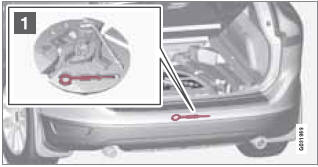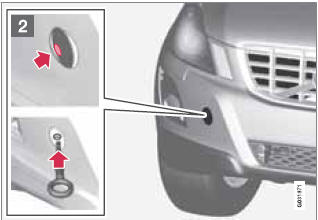Volvo XC60: Emergency towing
Towing eyelet

Location of the towing eyelet
 Attaching the towing eyelet
Attaching the towing eyelet
Attaching the towing eyelet
1 The towing eyelet is located under the floor of the cargo area, with the spare tire and may be partially concealed. This eyelet must be screwed into the positions provided on the right sides of either the front or rear bumper (see illustration).
2 There are two different types of covers over the openings for the towing eyelet and they have to be opened differently.
• If the cover has a notch, insert a coin, etc., into the notch and pry open the edge of the cover. Open the cover completely and remove it.
• If the cover has a mark along one edge or in a corner, press the mark while prying out the opposite side/corner using a coin, etc. Open the cover and remove it.
Screw the towing eyelet in place, first by hand and then using the tire iron until it is securely in place.
After the vehicle has been towed, the eyelet should be removed and returned to its storage location.
Press the cover for the attachment point back into position.
NOTE
On certain models equipped with a trailer
hitch, the towing eyelet cannot be screwed
into the hole in the rear bumper. The towing
rope should be attached to the trailer hitch
instead. For this reason, the detachable
section of the trailer hitch should be safely
stowed in the vehicle at all times.
CAUTION If the vehicle is being towed on a flat bed truck, the towing eyelets must not be used to pull the vehicle up onto the flat bed.
WARNING
• Remember that the power brakes and
power steering will not function when
engine is not running. The braking and
steering systems will function but considerably
higher pressure will be
required on the brake pedal and greater
steering effort must be exerted.
• The towing eyelets must not be used for
pulling the vehicle out of a ditch or for
any similar purpose involving severe
strain. Do not use the towing eyelets to
pull the vehicle up onto a flat bed tow
truck.
Precautions when the vehicle is being towed
• Attach jumper cables (see page 114) to provide current for releasing the electric parking brake and to move the gear selector from the P position to N.
• Be sure that the steering wheel lock is released (see page 90).
• While the vehicle is being towed, set the ignition in mode II if the battery is not drained so that the headlights/taillights can be switched on. See page 82 for information on the ignition modes.
• Maximum speed: 50 mph (80 km/h). Do not exceed the maximum allowable towing speed.
• Maximum distance with front wheels on ground: 50 miles (80 km).
• While the vehicle is being towed, try to keep the tow rope taut at all times.
• The vehicle should only be towed in the forward direction.
CAUTION Vehicles with AWD (All Wheel Drive) with the front wheels off the ground should not be towed at speeds above 50 mph (70 km/h) or for distances longer than 30 miles (50 km).
CAUTION
• Please check with state and local
authorities before attempting this type
of towing, as vehicles being towed are
subject to regulations regarding maximum
towing speed, length and type of
towing device, lighting, etc.
• If the vehicle's battery is dead, do not
attempt to start the vehicle by pushing
or pulling it as this will damage the
three-way catalytic converter(s). The
engine must be jump started using an
auxiliary battery (see page 114).
• If the vehicle is being towed on a flat bed
truck, the towing eyelets must not be
used to pull the vehicle up onto the flat
bed or to secure the vehicle on the flat
bed. Consult the tow truck operator.
Towing vehicles with front wheel drive/ All Wheel Drive
Volvo recommends the use of flat bed equipment.
• If wheel lift equipment must be used, please use extreme caution to help avoid damage to the vehicle. In this case, the vehicle should be towed with the rear wheels on the ground if at all possible.
• If it is absolutely necessary to tow the vehicle with the front wheels on the ground, please refer to the towing information on page 281.
CAUTION
• Sling-type equipment applied at the
front will damage radiator and air conditioning
lines.
• It is equally important not to use slingtype
equipment at the rear or apply lifting
equipment inside the rear wheels; serious damage to the rear axle may
result.
• If the vehicle is being towed on a flat bed
truck, the towing eyelets must not be
used to secure the vehicle on the flat
bed. Consult the tow truck operator.
See also:
Indicator lamps
Turn-signal indicator lamps/Hazard
warning indicator lamps
These indicator lamps blink on and off when a turn-signal lamp is operating.
NOTE:
● If the blinking is too fast, the cause may be a blown lamp bulb or a faulty turn-signal
conn ...
Emissions control system maintenance
The Scheduled Maintenance services listed in bold type
must be done at the times or mileages specified to ensure
the continued proper functioning of the emissions control
system. These and all other maintenance services included
in this manua ...

 Towing a trailer
Towing a trailer